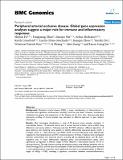| dc.contributor.author | Crawford, Keith | |
| dc.contributor.author | Jin, Jason Gang | |
| dc.contributor.author | Du, Yanzhi | |
| dc.contributor.author | Abzhanov, Arkhat | |
| dc.contributor.author | Zhou, Jianqin | |
| dc.contributor.author | Zhang, Ji | |
| dc.contributor.author | Jiang, Mier | |
| dc.contributor.author | Ohno-Machado, Lucila | |
| dc.contributor.author | Fu, Shijun | |
| dc.contributor.author | Zhao, Haiguang | |
| dc.contributor.author | Shi, Jiantao | |
| dc.contributor.author | Kuo, Winston | |
| dc.date.accessioned | 2009-05-13T14:34:22Z | |
| dc.date.issued | 2008 | |
| dc.identifier.citation | Fu, Shijun, Haiguang Zhao, Jiantao Shi, Arhat Abzhanov, Keith Crawford, Lucila Ohno-Machado, Jianqin Zhou, et al. 2008. Peripheral arterial occlusive disease: Global gene expression analyses suggest a major role for immune and inflammatory responses. BMC Genomics 9: 369-388. | en |
| dc.identifier.issn | 1471-2164 | en |
| dc.identifier.uri | http://nrs.harvard.edu/urn-3:HUL.InstRepos:2936368 | |
| dc.description.abstract | Background
Peripheral arterial disease (PAD), a major manifestation of atherosclerosis, is associated with significant cardiovascular morbidity, limb loss and death. However, mechanisms underlying the genesis and progression of the disease are far from clear. Genome-wide gene expression profiling of clinical samples may represent an effective approach to gain relevant information.
Results
After histological classification, a total of 30 femoral artery samples, including 11 intermediate lesions, 14 advanced lesions and 5 normal femoral arteries, were profiled using Affymetrix microarray platform. Following real-time RT-PCR validation, different algorithms of gene selection and clustering were applied to identify differentially expressed genes. Under a stringent cutoff, i.e., a false discovery rate (FDR) <0.5%, we found 366 genes were differentially regulated in intermediate lesions and 447 in advanced lesions. Of these, 116 genes were overlapped between intermediate and advanced lesions, including 68 up-regulated genes and 48 down-regulated ones. In these differentially regulated genes, immune/inflammatory genes were significantly up-regulated in different stages of PAD, (85/230 in intermediate lesions, 37/172 in advanced lesions). Through literature mining and pathway analysis using different databases such as Gene Ontology (GO), and the Kyoto Encyclopedia of Gene and Genomics (KEGG), genes involved in immune/inflammatory responses were significantly enriched in up-regulated genes at different stages of PAD(p < 0.05), revealing a significant correlation between immune/inflammatory responses and disease progression. Moreover, immune-related pathways such as Toll-like receptor signaling and natural killer cell mediated cytotoxicity were particularly enriched in intermediate and advanced lesions (P < 0.05), highlighting their pathogenic significance during disease progression.
Conclusion
Lines of evidence revealed in this study not only support previous hypotheses, primarily based on studies of animal models and other types of arterial disease, that inflammatory responses may influence the development of PAD, but also permit the recognition of a wide spectrum of immune/inflammatory genes that can serve as signatures for disease progression in PAD. Further studies of these signature molecules may eventually allow us to develop more sophisticated protocols for pharmaceutical interventions. | en |
| dc.description.sponsorship | Organismic and Evolutionary Biology | en |
| dc.language.iso | en_US | en |
| dc.publisher | BioMed Central | en |
| dc.relation.isversionof | http://dx.doi.org/10.1186/1471-2164-9-369 | en |
| dash.license | OAP | |
| dc.title | Peripheral Arterial Occlusive Disease: Global Gene Expression Analyses Suggest a Major Role for Immune and Inflammatory
Responses | en |
| dc.type | Journal Article | |
| dc.description.version | Version of Record | |
| dc.relation.journal | BMC Genomics | en |
| dash.depositing.author | Abzhanov, Arkhat | |
| dc.identifier.doi | 10.1186/1471-2164-9-369 | * |
| dash.authorsordered | false | |
| dash.contributor.affiliated | Abzhanov, Arkhat | |
| dash.contributor.affiliated | Kuo, Winston | |


